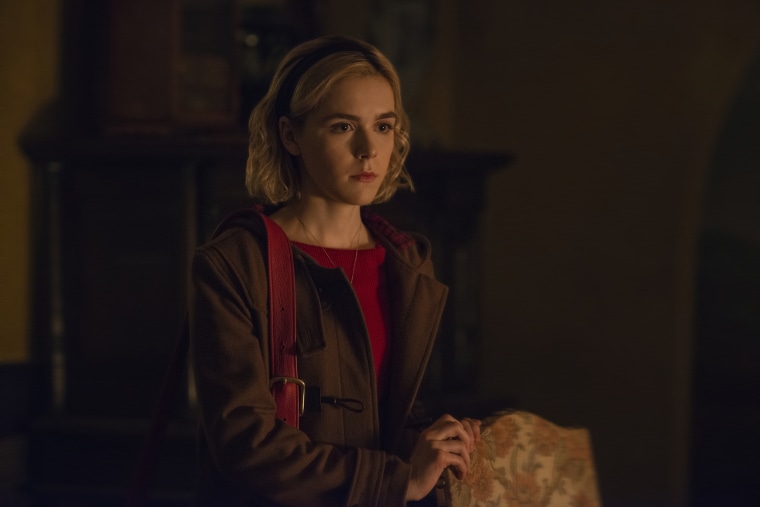In many ways,"Chilling Adventures of Sabrina" is the perfect 2018 update for ABC’s (and later The WB’s) brightly-lit, family-friendly "Sabrina The Teenage Witch," and a clever way to tackle the necessity and benefits of feminism: Through a horror lens.
Netflix’s "Sabrina" isn’t a reboot: It is its own individual, spooky entity thrusting viewers right into a dark — both literally and figuratively — world of witchcraft, Satanism, cannibalism and so on, down a distinctly female-centric, feminist path.
In it, Kiernan Shipka plays the half-mortal, half-witch Sabrina who, when we first meet her, is increasingly torn between her two worlds as she nears her 16th birthday. For witches, that birthday marks a much bigger event than a driver’s license: It’s their “dark baptism” — and event Sabrina casually compares to a Bat Mitzvah or Quinceanera — when they have to fully commit to a witchy life and, in our protagonist's case, leave all of her mortal friends behind to attend the Academy Of The Unseen Arts.
"Sabrina" gets a lot of mileage out of this push-and-pull, but its better moments aren’t focused on the question of what the protagonist will choose but instead why she would want to stay in the mortal world. There are benefits to signing over her soul, including more strength, ultimate power, a supportive coven and a stronger connection with her deceased birth father, a warlock.
But Sabrina, as she puts it, has “reservations about saving myself for the Dark Lord,” who is a not-so-subtle metaphor for the patriarchy that Sabrina battles in both the mortal and witch realm. She learns that the baptism involves far more than she was led to believe and she’s not ready to give up her personal freedom, individuality and free will.
Another reason why Sabrina is hesitant to leave the mortal world is simply because she’s built a nice life there. She has the Perfect Boyfriend, the blandly loveable Harvey Kinkle (Ross Lynch), and two best friends, Roz (Jaz Sinclair) and Susie (who is genderqueer and played by Lachlan Watson, who themself is non-binary). She wants to stick around, in part, to help and protect them, whether it’s by starting a feminist club to “topple the patriarchy” or by using magic to seek revenge on Susie’s football-player bullies. (With the inclusion of Susie and this club in the plot, the show demonstrates the benefits of feminism for everyone, as well as illustrating how cis women can and should better include and fight for trans and gender nonconforming communities.)
A common theme running through the 10-episode season is how women — both witch and mortal — are treated and disposed of by the men who run their worlds, and how they’re specifically taught to conform in order to further men’s lives. Through some of the older women in the coven, the series even touches on the ways in which women are used to uphold certain patriarchal standards against other women, whether knowingly or not. But the show's feminism is never overly preachy, it’s endearing even when it’s downright silly (cheekily, the initials for the club Sabrina starts spells out WICCA), and it’s endlessly quotable: “We don’t need a reason to torment mortal boys.”
It’s also nice to see a far more diverse cast than ABC’s original "Sabrina" (and many of the comics), and not just in terms of race. Susie’s relationship to gender is will be relatable to many genderqueer folks, while Sabrina’s cousin Ambrose (the great Chance Perdomo) is openly pansexual.
But what works best is the depiction of female anger. "Chilling Adventures" quickly introduces us to the story of the “Greendale 13” — not quite Salem, but a quieter witch hunt in Sabrina’s hometown — and the rage of those hanged witches reverberates throughout the season, building and building toward a conclusion. And, as Sabrina grows stronger and leans more toward her witch side, her rage is deployed beautifully and brilliantly, sometimes against the terrible boys in her mortal school, and other times against the “Weird Sisters,” a trio of impeccably-dressed witch classmates who certainly know how to make an entrance. (Even the sisters have reasons behind their anger that gets explored.)
This depiction is both timely and important, as it comes during a moment when women’s anger is righteous and valuable — and it’s important to note how Sabrina often channels her rage as a way to defend and protect her loved ones.
Still, what’s most successful about "Chilling Adventures of Sabrina" is how it blends its dark spirit with fun television that begs to be marathoned. There’s warlock orgies, a literal witch trial and hilariously cheesy dialogue (“Penny dreadful for your thoughts?”), but its solid attempt to blend high school dramatics with supernatural horror remains just as interesting as Sabrina’s own attempts to combine two distinct worlds.



